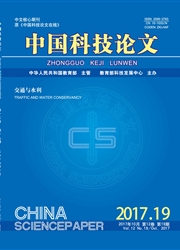

 中文摘要:
中文摘要:
利用SAP2000设计分析软件,按8度(0.2g)抗震设防要求对120m跨五心圆钢管拱桁架进行设计,然后采用考虑几何与材料双重非线性的集中塑性铰理论,对该拱桁架原结构和隔震结构进行地震波作用下的动力弹塑性分析,分别获得原结构和隔震结构的失效形态、塑性铰分布、整体变形及延性系数,比较并评定了原结构和隔震结构的失效类型、极限承载力和变形能力。结果表明:采用隔震支座结构第一周期约为原结构的2.7倍,自振周期得到延长,失效界限地震波加速度峰值相比原结构提高了255.9%,承载能力有明显提高;原结构和隔震结构在地震波作用下的失效类型均为动力失稳破坏,在达到失效界限加速度峰值时进入塑性的杆件数量均较少,主要集中在拱脚位置;原结构和隔震结构在2个主要受力方向均具有一定的延性性能,但其失效前的绝对变形较小,破坏前预兆性不显著。
 英文摘要:
英文摘要:
By using the design and analysis software of SAP2000, 120 m Span Five-Center-Arc Steel Spatial Arch Truss was de-signed based on the seismic requirement of 8 degree (0. 2 g). Meanwhile, the dynamic elastic-plastic analysis of the original struc-ture and isolation structure of the arch truss under seismic wave waspresented based on the concentrated plastic hinge theory in-cluding geometric and material nonlinearity. Thedynamic performance including failure form, plastic hinge distribution, deforma-tion, and structure ductility coefficient were alsoobtained. Thedynamic performances were evaluated and compared. The results showed that the first cycle of isolation structure with isolation bearing wasabout 2. 7 times of original structure andthe self-vibra-tion period of the isolation structure was extended. The peak value of failure limit acceleration of damping structure was 255. 9% higher than the original structureand its seismic performance wassignificantly. improved The failure types of original structure and isolation structure under the action of seismic waves wereelastic-plastic dynamic instability. When the peak value of failure limit acceleration was reached, the number of the members entering the plastic is low, mainly in the arch foot position. With some ductility, the absolute deformation was small before failure and there was no significant failure sign
 同期刊论文项目
同期刊论文项目
 同项目期刊论文
同项目期刊论文
 Elastic-plastic analysis on behaviors of thin spherical shell subjected to radial rectangular impuls
Elastic-plastic analysis on behaviors of thin spherical shell subjected to radial rectangular impuls Dynamic elasto-plastic analysis on the steel spatial arch truss with 30m span and 0.2 rise-span rati
Dynamic elasto-plastic analysis on the steel spatial arch truss with 30m span and 0.2 rise-span rati Dynamic elasto-plastic analysis on the steel spatial arch truss with 120 m span and 0.4 rise-span ra
Dynamic elasto-plastic analysis on the steel spatial arch truss with 120 m span and 0.4 rise-span ra Dynamic elasto-plastic analysis on the steel spatial arch truss with 30 m span and 0.1 rise-span rat
Dynamic elasto-plastic analysis on the steel spatial arch truss with 30 m span and 0.1 rise-span rat Dynamic elasto-plastic analysis on the steel spatial arch truss with 60m span and 0.1 rise-span rati
Dynamic elasto-plastic analysis on the steel spatial arch truss with 60m span and 0.1 rise-span rati Dynamic elasto-plastic analysis on the steel spatial arch truss with 90 m span and 0.3 rise-span rat
Dynamic elasto-plastic analysis on the steel spatial arch truss with 90 m span and 0.3 rise-span rat Dynamic elasto-plastic analysis on the steel spatial arch truss with 120 m span and 0.2 rise-span ra
Dynamic elasto-plastic analysis on the steel spatial arch truss with 120 m span and 0.2 rise-span ra Dynamic elasto-plastic analysis on the steel spatial arch truss with 90m span and 0.2 rise-span rati
Dynamic elasto-plastic analysis on the steel spatial arch truss with 90m span and 0.2 rise-span rati A study of counter-intuitive behaviors of pin-ended thin spherical shell subjected to rectangle impu
A study of counter-intuitive behaviors of pin-ended thin spherical shell subjected to rectangle impu 期刊信息
期刊信息
